Bento no. 76: Chicken and pepper rice cooker bento
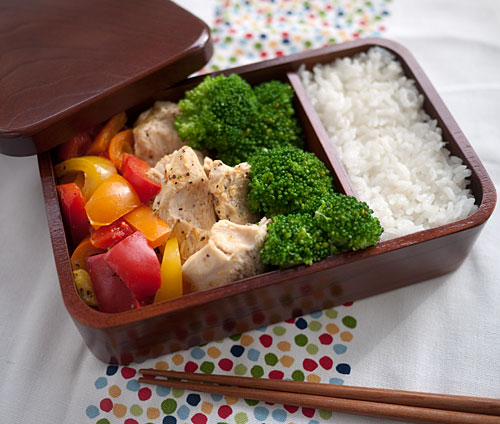
Bento contents:
- Chicken with peppers and sesame oil, 240 calories
- Broccoli with wasabi sauce, using stevia as the sweetener instead of sugar and halving the sake, 20 calories
- 1/2 cup (120ml) rice , 120 calories
Total calories (approx): 380 (how calories are calculated)
Time needed: 5 to 10 minutes prep time, plus 20-30 minutes of cooking time
Type: Japanese, made in a rice cooker
Shortly before I got stuck in a hospital and so on, I mentioned that I was basically without a kitchen. I've been free of the clutches of the hospital for a while now, but am still without a kitchen, since construction work has not begun yet. So I'm still relying on a few small appliances: a 2-burner hotplate, a microwave slash oven thing, an electric kettle, and most of all, my 20-plus-year old, trusty rice cooker, the one I inherited from my mother when she moved back to Japan. I've already posted a couple of bento-friendly rice cooker recipes, and I have more up my sleeve.
But what about using a rice cooker to make an entire bento? It can be done! This bento here may look rather familiar - it's almost identical in appearance to the one that is on the cover of my bento book in fact. What can I say, the combination of chicken and sweet peppers is a reliable standby for me. What makes this bento different though is that, except for the broccoli, which is made in advance and stashed in the refrigerator, everything is made at once in the rice cooker - with the flavors kept separate too.
So let's see how this is done.
Ingredients for chicken and pepper bento
This makes enough for 2 people. If you're making a bento for one, just halve the chicken and peppers, and reserve the extra rice for a later bento. You can also make more rice if you like and freeze the excess.
I used my old battered 5-cup Zojirushi rice cooker for this, but any rice cooker should work.
- 1 rice cooker cup of rice
- 2 large or 3 medium sweet bell peppers, de-seeded and cut into chunks
- 8 oz / 225g boneless, skinless chicken breast, cut into chunks
- 2 Tbsp sesame oil or other oil of your choice
- 1 Tbsp soy sauce
- a tiny bit of salt
- black pepper
Streamlining tip: Rinse the rice and put it in the cooker with the water the night before. Cut up the peppers and chicken and massage the chicken with the oil, and store in the refrigerator ready to go. In the morning, dump the foil packet on the rice, switch the cooker on, and go about your other morning activities until the rice cooker has finished its business.
Rinse your rice as usual (how to do it properly), put in the inner bowl of your rice cooker, and add enough water for 1 cup of rice.
Massage the oil into your chicken chunks with your hands very well. This step is important in order to end up with tender chicken, since breast meat tends to get dried out. In addition, the chicken chunks should be fairly large, about 1 inch / 2 cm or so square - very small bits will get overcooked and dry. You could use chicken thigh meat (dark meat has more fat in it so won't get tough and dried out as easily) instead.
Put the cut up peppers and chicken onto the middle of a sheet of aluminum foil that is cut large enough to wrap completely around the lot. Add the soy sauce, sprinkle of salt and black pepper and mix it up well right on the foil. (Note: If you object to the use of aluminum foil, you could use kitchen parchment paper instead.)
Note that you do not need to add any extra moisture here. The moisture of the peppers will be enough.
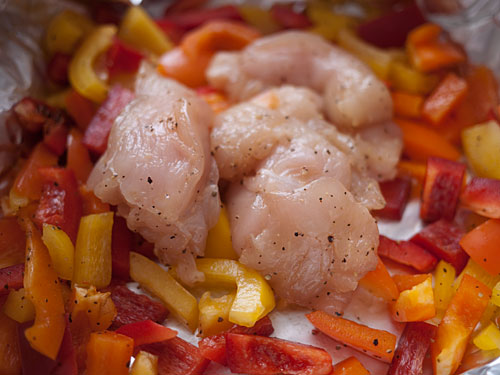
Gather up the foil over the mound of chicken and peppers and close it up to form a pouch. Make sure it's sealed well, unless you want pepper-chicken juice to drip on your rice. Put the pouch right on top of the rice. Switch the cooker on with the regular-rice setting, and go off to do other things.
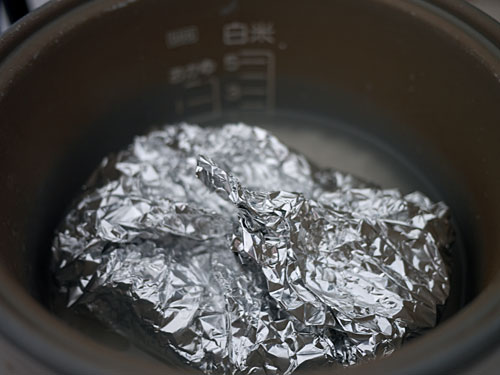
Here's how the pouch of chicken and peppers looks when it's done. There's just a bit of excess moisture in the foil. Drain this off when packing the chicken-peppers into your bento.
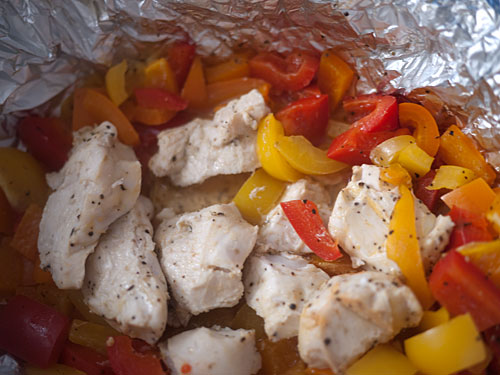
And here's the rice after the foil packet is removed. It has a funny dent in the middle but is otherwise perfectly cooked.

Now all you have to do is to pack your bento! Remember to put the rice in first, let it cool down, then pack the other ingredients. Note that I packed just a little rice in my box - the rest of the rice got packed into The Guy's box.
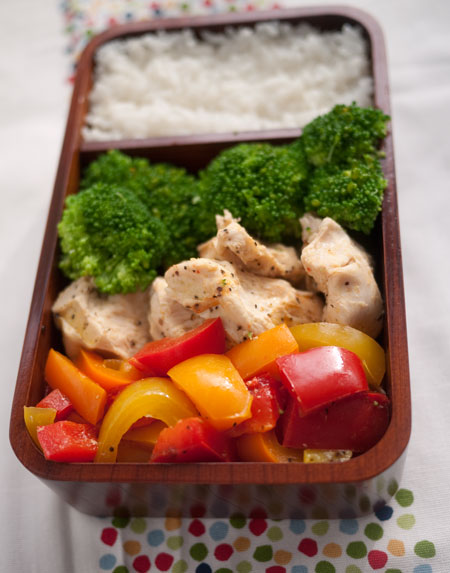
I did do the broccoli separately here, but you could steam-cook it along with the rice if you like. Just put it in its own foil packet and dump it on top of the rice. It will come out a bit overcooked and greyish-green though.
So what's going on here?
You are essentially using the heat of the steam that is generated by the rice cooker as it cooks the rice, to cook the chicken and peppers in the foil packet too. Since the rice cooker is a small, closed environment, this works very well. It's really the same principle as cooking in a foil or paper packet in an oven or on the stove top (the French cooking term for this method is en papillote), but since you're not heating up another appliance you're saving a bit of energy too. And the flavors are kept separate! You could do this in any place that you can plug in a rice cooker - in a dorm room for example, which is, as I mentioned earlier, essentially what I'm living in now, sort of. (Note that I didn't come up with this method on my own; I've seen it in a couple of Japanese cookbooks, which I have adapted. None of the books I've seen used it for making an all-in-one bento though!)
One caution: don't put a foil packet directly in contact with the bottom surface of your rice cooker bowl. It gets very hot there, and your foil may blacken and even develop holes. Put it on top of a bed of grains though, and you'll be fine. (I don't know why the rice doesn't burn on the bottom. That is the magic of rice cookers.)
This method can be used for a lot of other bento combinations - change the grains, change the things you put in the foil packet, and so on. As I experiment with some of mine you'll see them showing up here of course. In the meantime, see what combinations you can come up with on your own!
The inevitable question someone is going to ask - will this work in a slow cooker / crockpot?
It may. I don't own either of those at the moment, so I can't try it out I'm afraid. If you do, let us know how it turns out.
The bento box I used
This is the one tier Nara bento box, which is made of real wood. It's available from Bento&co. Since it is a real wooden box it needs to be treated with some care, and must be carried upright (wrapped in a furoshiki cloth ideally) to prevent it from spilling over. In fact, a wooden bento box goes against just about all the requirements for the 'ideal' bento box. However, it makes the food packed within look so nice that it's worth the trouble on occasion. See how to take care of a wooden bento box.
Speaking of rice cooker cooking....
There is a new book coming out soon by film critic Roger Ebert - a rice cooker cookbook no less. Based on this post on his famous and very popuar blog, it looks to be quite an interesting read! (Note that he too favors Zojirushi rice cookers; he seems to like their most basic model.) Here is a New York Times article about the book and Mr. Ebert, who hasn't been able to eat since losing his jaw to cancer, but still can write beautifully about food. And here's a Q and A with him. His taste in food movies is, in my opinion, impeccable. (One of these days I'm going to write up an extensive, scene-by-scene cultural and culinaric analysis of Tampopo...)
If you enjoyed this article, please consider supporting this site by becoming my patron via Patreon.
